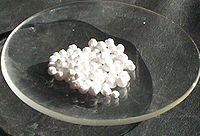Potassium bromide
 |
|
 |
|
| Identifiers | |
|---|---|
|
3D model (Jmol)
|
|
| ChEBI | |
| ChemSpider | |
| ECHA InfoCard | 100.028.937 |
|
PubChem CID
|
|
| RTECS number | TS7650000 |
| UNII | |
|
|
|
|
| Properties | |
| KBr | |
| Molar mass | 119.002 g/mol |
| Appearance | white solid |
| Odor | odorless |
| Density | 2.74 g/cm3 |
| Melting point | 734 °C (1,353 °F; 1,007 K) |
| Boiling point | 1,435 °C (2,615 °F; 1,708 K) |
| 535 g/L (0 °C) 678 g/L (25 °C) 1020 g/L (100 °C) |
|
| Solubility | very slightly soluble in diethyl ether |
| Solubility in glycerol | 217 g/L |
| Solubility in ethanol | 47.6 g/L (80 °C) |
| −49.1·10−6 cm3/mol | |
|
Refractive index (nD)
|
1.559 |
| Structure | |
| Sodium chloride | |
| octahedral | |
| 10.41 D (gas) | |
| Pharmacology | |
| QN03AX91 (WHO) | |
| Hazards | |
| GHS pictograms |  |
| GHS signal word | Warning |
| H319 | |
| P280, P305+351+338, P337+313 | |
| R-phrases | R20, R21, R22, R36, R37, R38 |
| S-phrases | S22, S26, S36 |
| Lethal dose or concentration (LD, LC): | |
|
LD50 (median dose)
|
3070 mg/kg (oral, rat) |
| Related compounds | |
|
Other anions
|
Potassium fluoride Potassium chloride Potassium iodide Potassium astatide |
|
Other cations
|
Lithium bromide Sodium bromide Rubidium bromide Caesium bromide Francium bromide |
|
Except where otherwise noted, data are given for materials in their standard state (at 25 °C [77 °F], 100 kPa).
|
|
|
|
|
| Infobox references | |
Potassium bromide (KBr) is a salt, widely used as an anticonvulsant and a sedative in the late 19th and early 20th centuries, with over-the-counter use extending to 1975 in the US. Its action is due to the bromide ion (sodium bromide is equally effective). Potassium bromide is used as a veterinary drug, as an antiepileptic medication for dogs.
Under standard conditions, potassium bromide is a white crystalline powder. It is freely soluble in water; it is not soluble in acetonitrile. In a dilute aqueous solution, potassium bromide tastes sweet, at higher concentrations it tastes bitter, and tastes salty when the concentration is even higher. These effects are mainly due to the properties of the potassium ion—sodium bromide tastes salty at any concentration. In high concentration, potassium bromide strongly irritates the gastric mucous membrane, causing nausea and sometimes vomiting (a typical effect of all soluble potassium salts).
Potassium bromide, a typical ionic salt, is fully dissociated and near pH 7 in aqueous solution. It serves as a source of bromide ions. This reaction is important for the manufacture of silver bromide for photographic film:
Aqueous bromide Br− also forms complexes when reacted with some metal halides such as copper(II) bromide:
A traditional method for the manufacture of KBr is the reaction of potassium carbonate with an iron(III,III, II) bromide, Fe3Br8, made by treating scrap iron under water with excess bromine:
The anticonvulsant properties of potassium bromide were first noted by Sir Charles Locock at a meeting of the Royal Medical and Chirurgical Society in 1857. Bromide can be regarded as the first effective medication for epilepsy. At the time, it was commonly thought that epilepsy was caused by masturbation. Locock noted that bromide calmed sexual excitement and thought this was responsible for his success in treating seizures. In the latter half of the 19th century, potassium bromide was used for the calming of seizure and nervous disorders on an enormous scale, with the use by single hospitals being as much as several tons a year (the dose for a given person being a few grams per day).
...
Wikipedia
